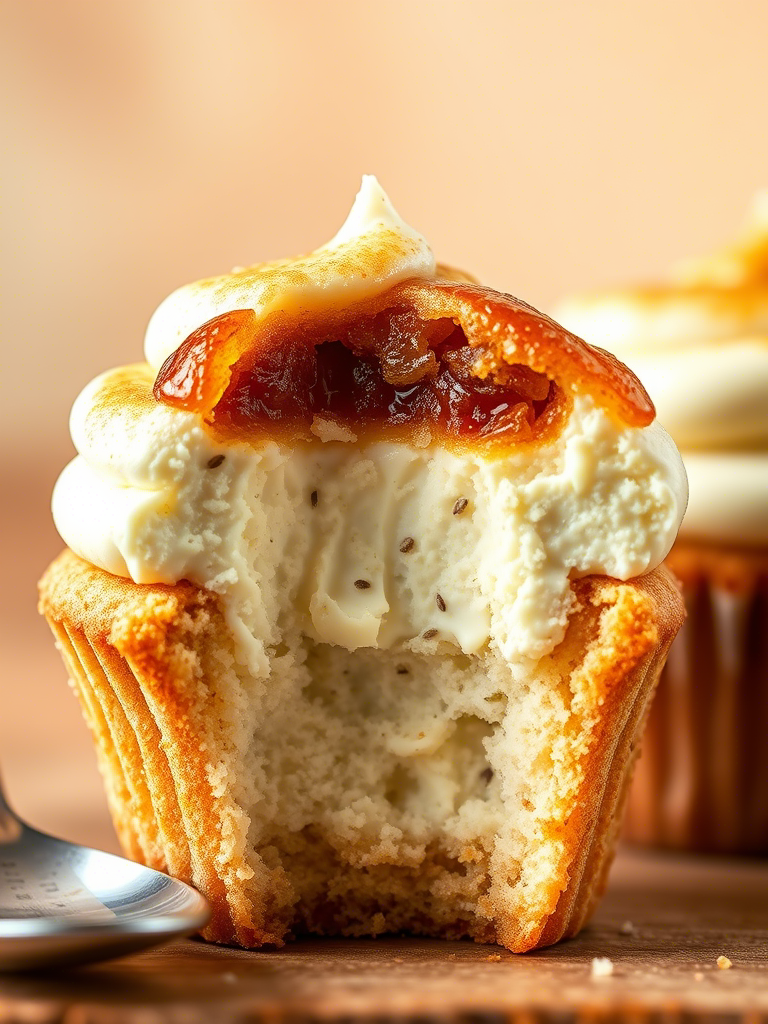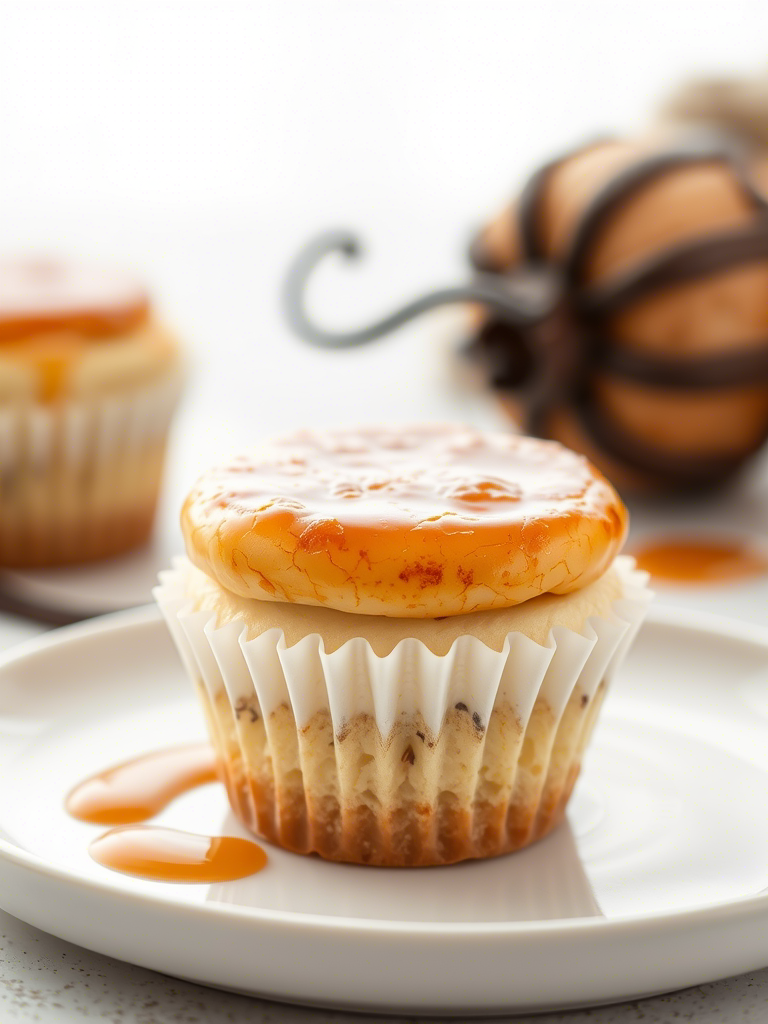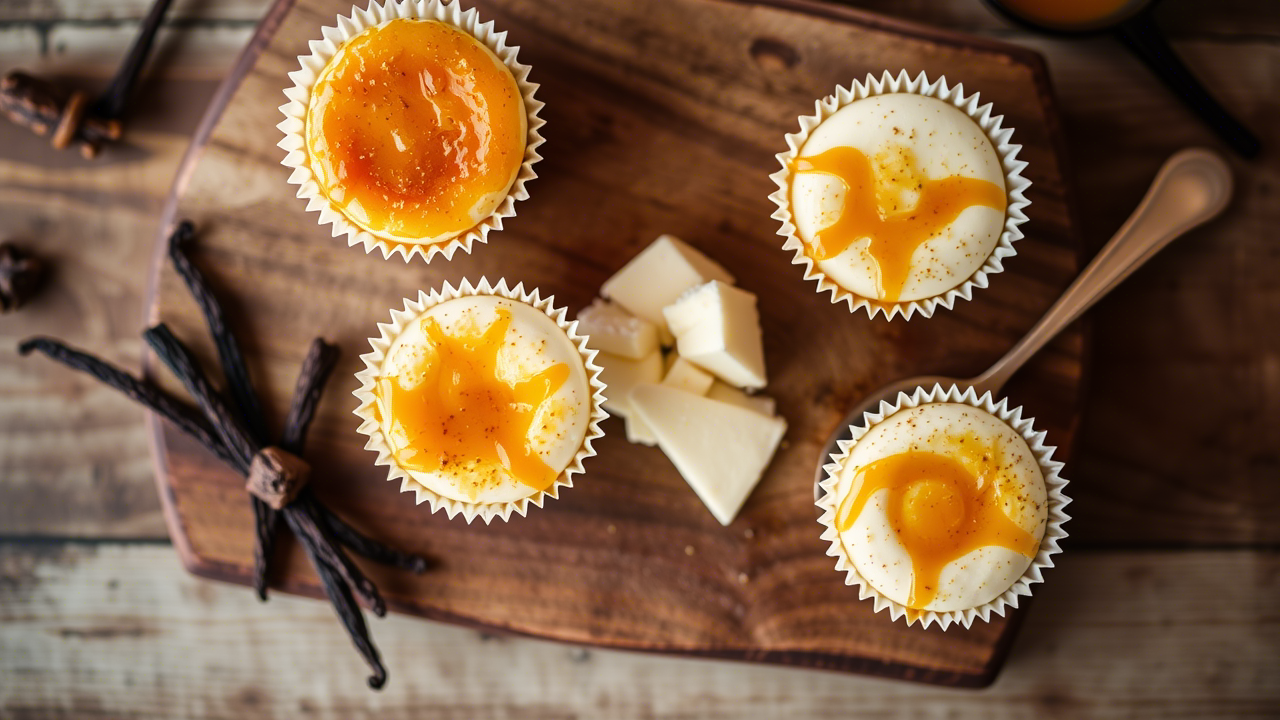You don’t forget the first time you torch a brûlée. That sharp crack of caramelized sugar—golden, glass-like, dramatic—is addictive. Now picture that same textural drama, that flavor density, layered on top of a silky, baked vanilla bean cheesecake… and nestled inside a cupcake liner. Yep, it’s happening. And it’s not just cute food. This is serious dessert engineering.
Today we’re diving deep—chef’s jacket off, blowtorch in hand—into the anatomy, science, and real-world applications of Vanilla Bean Crème Brûlée Cheesecake Cupcakes. From base to brûlée, we’ll pull apart what makes this hybrid so craveable, so commercially viable, and frankly, so damn irresistible.
What Exactly Are We Dealing With Here?
It’s not a cupcake. Not really. It’s not a cheesecake either. And it’s definitely not just crème brûlée in disguise.
This dessert is a multi-layered pastry innovation that marries the dense creaminess of New York-style cheesecake with the theatrical top-note of a French crème brûlée, scaled to cupcake size for individual serving—and better margins. You’re looking at three technical layers: a crisp graham or shortbread base, a baked vanilla bean cheesecake center, and a torched, custard-like top with caramelized sugar.
And no, the top isn’t real crème brûlée custard—it’s a brûléed cheesecake top, but with some custard-like cheats to get that jiggle. We’ll get into the build, the science, and why it all matters.
Why This Dessert’s Having a Moment
Pastry trends move fast. Cronuts, macaron towers, burnt Basque cheesecake—all had their time. But this? This is different. It’s hybridized, yes, but it also taps into nostalgia.
Cheesecake? Classic. Crème brûlée? Fancy. Together? You’ve got a menu item that works for upscale weddings, Instagram foodies, and grab-and-go counters at high-end bakeries. According to a 2024 Nielsen flavor trend report, vanilla bean ranks top 3 globally for consumer dessert preferences, and cheesecake sits in the top 5 most-ordered plated desserts in U.S. restaurants. This fusion capitalizes on both stats. And it scales well.
Crafting the Perfect Crust: Don’t Phone This In
Most bakers screw up the crust. Either it’s too thick, too wet, or just… there, like an afterthought. But in a small-format dessert like this, your crust is 25% of the bite. It matters.
For professionals, a 2:1 ratio of crushed graham to melted butter is the default, but that’s lazy. Add a tablespoon of almond flour or blitzed toasted hazelnuts. Why? Because it dries the mix slightly and adds complexity, and it keeps the base from turning soggy after refrigeration. Press just enough into the liner to form a shell, not a slab. Bake it blind—just 5 minutes at 350°F—to firm it before the cheesecake layer goes on.
You want a crust that tastes like effort. Not a soggy granola bar.

The Cheesecake Base: Vanilla Bean or Bust
Here’s the thing about vanilla: the fake stuff will betray you. Especially in something this stripped down. You’re not hiding behind cocoa or fruit or caramel. It’s vanilla, front and center.
Always use real vanilla bean paste or the scraped seeds of a Madagascar bean. The flavor’s floral, deep, almost marshmallowy if you hit it right. Skip the extract unless it’s cold-infused. Combine that with cream cheese (full fat only, please—don’t bring Philadelphia “lite” in here), a touch of sour cream, and egg. That’s your holy trio for texture.
Now, here’s the pro move: mix low and slow. Overmixing adds air, which leads to cracks and a weird mousse-y texture. You want a dense, luscious bake. Bake it low too—300°F—and do it in a water bath if your pans can handle it. Otherwise, just put a tray of water in the oven below your rack. Steam is your friend.
Cheesecake is not a rush job. Ever.
The Brûlée Layer: Theatrics + Technique
This is where it gets fun.
Classic crème brûlée uses a custard base of egg yolks, sugar, and cream, slow-baked in a ramekin. We’re not doing that here. But we want that finish—the creamy top, the caramel snap, the faint bitterness of burnt sugar.
So how? You torch the top of the baked cheesecake. But before that, you brush on a whisper of cream or melted custard mix—just a film. It softens the texture enough to fake a brûlée mouthfeel. Then chill. After at least 4 hours (overnight is better), you hit each cupcake with a layer of superfine sugar and torch it slowly in circular motions. Don’t rush. Let the sugar bubble, amber, and set. If it’s smoking, you’ve gone too far.
Oh, and don’t brûlée too far ahead of service. That crackly top turns sticky in the fridge. You want to serve it within 2 hours of torching. Yes, even if that means torching 50 of them at 4:30 pm.
Equipment Makes or Breaks It
You need a proper torch. Don’t try to brûlée with a kitchen lighter or some camping gear knockoff. Use a propane torch designed for culinary use. I prefer the Bernzomatic TS8000—it’s overkill, but you get gorgeous control.
You’ll also want heavy cupcake pans, not those cheap aluminum ones. They conduct heat better and protect the cheesecake from overbaking at the edges.
For liners, use greaseproof parchment cups. Foil ones will mess with even baking. And skip silicone molds unless you want to destroy the crust during unmolding.

Storage, Shelf-Life, and Scaling for Service
Here’s the deal: these cupcakes hold beautifully in refrigeration for 48 hours un-torched. After torching, they’re best that day. For restaurants, torching to order is ideal but often impractical. A workaround is batch torching for small parties, then keeping them loosely covered in the fridge for up to 3 hours max.
They freeze well pre-brûlée. Just defrost overnight in the fridge and torch when needed.
Packaging for retail? Use clear domed cupcake containers and slap a label on that says “Torch Top for Crunch!”—customers love the DIY angle. Or include a packet of brûlée sugar and instructions.
Common Mistakes (That Will Cost You Stars or Stars on Yelp)
- Overbaking. The centers should wobble. Like a lazy belly.
- Using imitation vanilla. Your guests will taste the lie.
- Torching too close. You’ll char it instead of caramelizing.
- Not chilling enough before torching. You’ll melt the top.
- Overloading the crust. You’ll end up with a biscuit, not a base.
Avoid those, and you’re golden—literally.
Real-World Applications and Trends
High-end bakeries are already all over this. Dominique Ansel prototyped a brûlée tart in 2023 that sold out daily. Milk Bar has tested brûlée-style cheesecake bites in NYC. And caterers are offering DIY brûlée cupcake bars with guest torches at weddings—yes, really.
For food trucks and mobile caterers, this dessert checks all the boxes: preppable, dramatic, upsell-able. At $5–$7 per unit, you’re looking at 300%+ profit margins if your labor’s tight.
Want to go further? Try variations:
- Salted caramel + bourbon brûlée
- Matcha cheesecake + yuzu brûlée
- Coconut crust + mango-passion brûlée top
Let your pastry brain run wild. But get the basics right first.
Final Thoughts: Why It Matters
Vanilla Bean Crème Brûlée Cheesecake Cupcakes aren’t just a trend. They’re a blueprint for what dessert has become—layered, nostalgic, Instagrammable, and scalable. They hit that balance of technique and delight. And when done right, they remind people why pastry is an art.
So yeah. It’s just a cupcake. But it’s also not.
Pull the torch trigger and give them that crackle. It’s a moment they’ll remember. And probably post.
Now go bake some damn good ones.
FAQs
What are Vanilla Bean Crème Brûlée Cheesecake Cupcakes?
They’re individual desserts combining graham crust, vanilla bean cheesecake, and a brûléed sugar top.
Can I use vanilla extract instead of vanilla bean?
You can, but it won’t have the depth or visual appeal—use paste or real beans if you can.
Do I need a water bath to bake them?
Not strictly, but using steam (or a water tray) helps prevent cracks and keeps them creamy.
How long do they last in the fridge?
Up to 48 hours un-torched, but only a few hours after brûlée before the sugar softens.
Can I freeze them?
Yes, freeze without the sugar topping and torch after thawing for best texture.
What sugar is best for torching?
Use superfine (caster) sugar—it melts evenly and caramelizes without burning too fast.
How do I prevent overbaking the cheesecake?
Bake low and slow until the center wobbles slightly; don’t wait for it to firm completely.
Can I make these without a torch?
Technically yes, using a broiler, but you’ll lose precision and may melt the cheesecake.
Are these suitable for catering or events?
Absolutely—they’re elegant, scalable, and can be prepped ahead and torched on-site.
What are some popular flavor variations?
Try salted caramel, matcha-yuzu, espresso swirl, or fruit curds layered under the brûlée.

Mariana is a passionate home cook who creates delicious, easy-to-follow recipes for busy people. From energizing breakfasts to satisfying dinners and indulgent desserts, her dishes are designed to fuel both your body and hustle.
When she’s not in the kitchen, she’s exploring new flavors and dreaming up her next recipe to share with the Foodie Hustle community.

